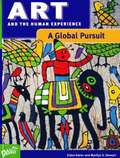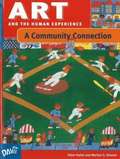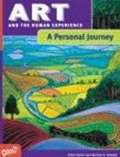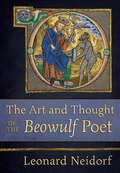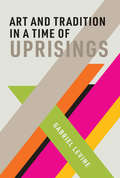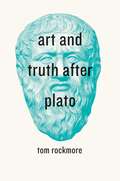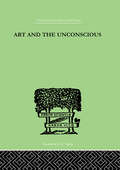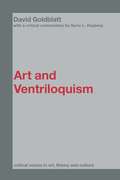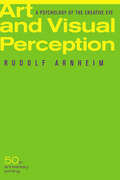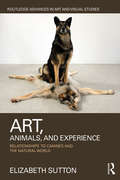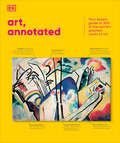- Table View
- List View
Art and the Global Economy
by John ZarobellArt and the Global Economy analyzes major changes in the global art world that have emerged in the last twenty years including structural shifts in the global art market; the proliferation of international art fairs, biennials and blockbuster exhibitions; and the internationalization of the scope of contemporary art. John Zarobell explores the economic and social transformations in the cultural sphere, the results of greater access to information about art, exhibitions, and markets around the world, as well as the increasing interpenetration of formerly distinct geographical domains. By considering a variety of locations—both long-standing art capitals and up-and-coming centers of the future—Art and the Global Economy facilitates a deeper understanding of how globalization affects the domain of the visual arts in the twenty-first century. With contributions by Lucia Cantero, Mariana David, Valentin Diaconov, Kai Lossgott, Grace Murray, Chhoti Rao, Emma Rogers and Michelle Wong.
Art and the Human Experience: A Global Pursuit
by Eldon Katter Marilyn G. StewartLEVEL: Middle School. Teach the BIG IDEAS using the basic foundations of art. Elements and Principles -- Focus on mastering art's building blocks: Line and pattern; Light, value, and contrast; Proportion and scale, and more. Art History -- Focus on the Western world: Covers the ancient world to the present; Connects to each chapter's themes; Timeline and historical context in every chapter. Multicultural -- Focus on world cultural contributions to art: Native North America; China and Korea and more; Maps in every chapter.
Art and the Human Experience: A Community Connection
by Eldon Katter Marilyn G. StewartThis book provides a structured exploration of art with the flexibility to zoom in on topics that interest the reader.
Art and the Human Experience: A Personal Journey
by Eldon Katter Marilyn G. StewartLEVEL: Middle School. Teach the BIG IDEAS using the basic foundations of art. Skills and Techniques -- Focus on basic skill development: Gesture and contour; Proportions; Perspective and more. Art History -- Focus on major genres: Portraits; Fantasy; Architecture and more. Multicultural -- Focus personal encounters with diverse artists: Haiti; Puerto Rico, Israel, and more. Maps in every chapter.
Art and the Human Experience: A Personal Journey
by Eldon Katter Marilyn G. StewartLEVEL: Middle School. Teach the BIG IDEAS using the basic foundations of art. Skills and Techniques -- Focus on basic skill development: Gesture and contour; Proportions; Perspective and more. Art History -- Focus on major genres: Portraits; Fantasy; Architecture and more. Multicultural -- Focus personal encounters with diverse artists: Haiti; Puerto Rico, Israel, and more. Maps in every chapter.
Art and the Market
by Craufurd D. GoodwinRoger Fry, a core member of the Bloomsbury Group, was involved with all aspects of the art market as artist, critic, curator, historian, journalist, advisor to collectors, and gallery operator. He is especially remembered as the person who introduced postimpressionist art to Britain. Reprinted in this volume are seventeen of Fry's works on commerce in art. Although he had no formal training in economics, Fry addressed the art market as a modern economist might do. It is therefore fitting that his writings receive here an original interpretation from the perspective of a modern economist, Craufurd D. Goodwin. Goodwin explores why Fry's work is both a landmark in the history of cross-disciplinary thought and a source of fresh insights into a wide range of current policy questions. The new writings included contain Fry's most important contributions to theory, history, and debates over policy as he explored the determinants of the supply of art, the demand for art, and the art market institutions that facilitate exchange. His ideas and speculations are as stimulating and provocative today as when they were written.
Art and the Performance of Memory: Sounds and Gestures of Recollection (Routledge Studies in Memory and Narrative)
by Richard Cándida SmithThis book investigates the role that the visual and performing arts play in our experience and understanding of the past. Expanding upon longstanding concerns in cultural history about the relation of text and image, the book highlights the distinction between enactive and cognitive memory and the implications of this for artists and their publics.
Art and the Religious Image in El Greco’s Italy
by Andrew R. CasperArt and the Religious Image in El Greco’s Italy is the first book-length examination of the early career of one of the early modern period’s most notoriously misunderstood figures. Born around 1541, Domenikos Theotokopoulos began his career as an icon painter on the island of Crete. He is best known, under the name “El Greco,” for the works he created while in Spain, paintings that have provoked both rapt admiration and scornful disapproval since his death in 1614. But the nearly ten years he spent in Venice and Rome, from 1567 to 1576, have remained underexplored until now. Andrew Casper’s examination of this period allows us to gain a proper understanding of El Greco’s entire career and reveals much about the tumultuous environment for religious painting after the Council of Trent.Art and the Religious Image in El Greco’s Italy is a new book in the Art History Publication Initiative (AHPI), a collaborative grant from the Andrew W. Mellon Foundation. Thanks to the AHPI grant, this book will be available in popular e-book formats.
Art and the Religious Image in El Greco’s Italy
by Andrew R. CasperArt and the Religious Image in El Greco’s Italy is the first book-length examination of the early career of one of the early modern period’s most notoriously misunderstood figures. Born around 1541, Domenikos Theotokopoulos began his career as an icon painter on the island of Crete. He is best known, under the name “El Greco,” for the works he created while in Spain, paintings that have provoked both rapt admiration and scornful disapproval since his death in 1614. But the nearly ten years he spent in Venice and Rome, from 1567 to 1576, have remained underexplored until now. Andrew Casper’s examination of this period allows us to gain a proper understanding of El Greco’s entire career and reveals much about the tumultuous environment for religious painting after the Council of Trent.Art and the Religious Image in El Greco’s Italy is a new book in the Art History Publication Initiative (AHPI), a collaborative grant from the Andrew W. Mellon Foundation. Thanks to the AHPI grant, this book will be available in popular e-book formats.
Art and the Transitional Object in Vernon Lee's Supernatural Tales
by Patricia PulhamIn her persuasively argued study, Patricia Pulham astutely combines psychoanalytic theory with socio-historical criticism to examine a selection of fantastic tales by the female aesthete and intellectual Vernon Lee (Violet Paget, 1856-1935). Lee's own definition of the supernatural in the preface to Hauntings questions the nature of the 'genuine ghost', and argues that this figure is not found in the Society of Psychical Research but in our own psyches, where it functions as a mediator between past and present. Using D.W. Winnicott's 'transitional object' theory, which maintains that adults transfer their childhood engagement with toys to art and cultural artifacts, Pulham argues that the prevalence of the past in Lee's tales signifies not only an historical but a psychic past. Thus the 'ghosts' that haunt Lee's supernatural fiction, as well as her aesthetic, psychological, and historical writings, held complex meanings for her that were fundamental to her intellectual development and allowed her to explore alternative identities that permit the expression of transgressive sexualities.
The Art and Thought of Heraclitus
by Charles H. KahnBehind the superficial obscurity of what fragments we have of Heraclitus' thought, Professor Kahn claims that it is possible to detect a systematic view of human existence, a theory of language which sees ambiguity as a device for the expression of multiple meaning, and a vision of human life and death within the larger order of nature. The fragments are presented here in a readable order; translation and commentary aim to make accessible the power and originality of a systematic thinker and a great master of artistic prose. The commentary locates Heraclitus within the tradition of early Greek thought, but stresses the importance of his ideas for topical theories of language, literature and philosophy.
The Art and Thought of the "Beowulf" Poet
by Leonard NeidorfIn The Art and Thought of the Beowulf Poet, Leonard Neidorf explores the relationship between Beowulf and the legendary tradition that existed prior to its composition. The Beowulf poet inherited an amoral heroic tradition, which focused principally on heroes compelled by circumstances to commit horrendous deeds: fathers kill sons, brothers kill brothers, and wives kill husbands. Medieval Germanic poets relished the depiction of a hero's unyielding response to a cruel fate, but the Beowulf poet refused to construct an epic around this traditional plot. Focusing instead on a courteous and pious protagonist's fight against monsters, the poet creates a work that is deeply untraditional in both its plot and its values. In Beowulf, the kin-slayers and oath-breakers of antecedent tradition are confined to the background, while the poet fills the foreground with unconventional characters, who abstain from transgression, display courtly etiquette, and express monotheistic convictions. Comparing Beowulf with its medieval German and Scandinavian analogues, The Art and Thought of the Beowulf Poet argues that the poem's uniqueness reflects one poet's coherent plan for the moral renovation of an amoral heroic tradition. In Beowulf, Neidorf discerns the presence of a singular mind at work in the combination and modification of heroic, folkloric, hagiographical, and historical materials. Rather than perceive Beowulf as an impersonally generated object, Neidorf argues that it should be read as the considered result of one poet's ambition to produce a morally edifying, theologically palatable, and historically plausible epic out of material that could not independently constitute such a poem.
Art and Tradition in a Time of Uprisings
by Gabriel LevineExamining radical reinventions of traditional practices, ranging from a queer reclamation of the Jewish festival of Purim to an Indigenous remixing of musical traditions.Supposedly outmoded modes of doing and making—from music and religious rituals to crafting and cooking—are flourishing, both artistically and politically, in the digital age. In this book, Gabriel Levine examines collective projects that reclaim and reinvent tradition in contemporary North America, both within and beyond the frames of art. Levine argues that, in a time of political reaction and mass uprisings, the subversion of the traditional is galvanizing artists, activists, musicians, and people in everyday life. He shows that this takes place in strikingly different ways for Indigenous and non-Indigenous people in settler colonies. Paradoxically, experimenting with practices that have been abandoned or suppressed can offer powerful resources for creation and struggle in the present.Levine shows that, in projects that span “the discontinuum of tradition,” strange encounters take place across the lines of class, Indigeneity, race, and generations. These encounters spark alliance and appropriation, desire and misunderstanding, creative (mis)translation and radical revisionism. He describes the yearly Purim Extravaganza, which gathers queer, leftist, and Yiddishist New Yorkers in a profane reappropriation of the springtime Jewish festival; the Ottawa-based Indigenous DJ collective A Tribe Called Red, who combine traditional powwow drumming and singing with electronic dance music; and the revival of home fermentation practices—considering it from microbiological, philosophical, aesthetic, and political angles.Projects that take back the vernacular in this way, Levine argues, not only develop innovative forms of practice for a time of uprisings; they can also work toward collectively reclaiming, remaking, and repairing a damaged world.
Art and Truth after Plato
by Tom RockmoreDespite its foundational role in the history of philosophy, Plato's famous argument that art does not have access to truth or knowledge is now rarely examined, in part because recent philosophers have assumed that Plato's challenge was resolved long ago. In Art and Truth after Plato, Tom Rockmore argues that Plato has in fact never been satisfactorily answered--and to demonstrate that, he offers a comprehensive account of Plato's influence through nearly the whole history of Western aesthetics. Rockmore offers a cogent reading of the post-Platonic aesthetic tradition as a series of responses to Plato's position, examining a stunning diversity of thinkers and ideas. He visits Aristotle's Poetics, the medieval Christians, Kant's Critique of Judgment, Hegel's phenomenology, Marxism, social realism, Heidegger, and many other works and thinkers, ending with a powerful synthesis that lands on four central aesthetic arguments that philosophers have debated. More than a mere history of aesthetics, Art and Truth after Plato presents a fresh look at an ancient question, bringing it into contemporary relief.
Art and Truth after Plato
by Tom RockmoreDespite its foundational role in the history of philosophy, Plato’s famous argument that art does not have access to truth or knowledge is now rarely examined, in part because recent philosophers have assumed that Plato’s challenge was resolved long ago. In Art and Truth after Plato, Tom Rockmore argues that Plato has in fact never been satisfactorily answered—and to demonstrate that, he offers a comprehensive account of Plato’s influence through nearly the whole history of Western aesthetics. Rockmore offers a cogent reading of the post-Platonic aesthetic tradition as a series of responses to Plato’s position, examining a stunning diversity of thinkers and ideas. He visits Aristotle’s Poetics, the medieval Christians, Kant’s Critique of Judgment, Hegel’s phenomenology, Marxism, social realism, Heidegger, and many other works and thinkers, ending with a powerful synthesis that lands on four central aesthetic arguments that philosophers have debated. More than a mere history of aesthetics, Art and Truth after Plato presents a fresh look at an ancient question, bringing it into contemporary relief.
Art And The Unconscious: A Psychological Approach to a Problem of Philosophy (International Library Of Psychology Ser.)
by Thorburn, John MFirst published in 1999. Routledge is an imprint of Taylor & Francis, an informa company.
Art and Ventriloquism (Critical Voices in Art, Theory and Culture)
by David GoldblattThis exciting collection of David Goldblatt's essays, available for the first time in one volume, uses the metaphor of ventriloquism to help understand a variety of art world phenomena. It examines how the vocal vacillation between ventriloquist and dummy works within the roles of artist, artwork and audience as a conveyance to the audience of the performer's intentions, emotions and beliefs through a created performative persona. Considering key works, including those of Nietzsche, Foucault, Socrates, Derrida, Cavell and Wittgenstein, Goldblatt examines how the authors use the framework of ventriloquism to construct and negate issues in art and architecture. He ponders 'self-plagiarism'; why the classic philosopher cannot speak for himself, but must voice his thoughts through fictional characters or inanimate objects and works. With a close analysis of two ventriloquist paintings by Jasper Johns and Paul Klee, a critical commentary by Garry L. Hagberg, and preface by series editor Saul Ostrow, Goldblatt's thoroughly fascinating book will be an invaluable asset to students of cultural studies, art, and philosophy.
Art and Vision in the Inca Empire
by Adam HerringIn 1500 CE, the Inca empire covered most of South America's Andean region. The empire's leaders first met Europeans on November 15, 1532, when a large Inca army confronted Francisco Pizarro's band of adventurers in the highland Andean valley of Cajamarca, Peru. At few other times in its history would the Inca royal leadership so aggressively showcase its moral authority and political power. Glittering and truculent, what Europeans witnessed at Inca Cajamarca compels revised understandings of pre-contact Inca visual art, spatial practice, and bodily expression. This book takes a fresh look at the encounter at Cajamarca, using the episode to offer a new, art-historical interpretation of pre-contact Inca culture and power. Adam Herring's study offers close readings of Inca and Andean art in a variety of media: architecture and landscape, geoglyphs, sculpture, textiles, ceramics, featherwork and metalwork. The volume is richly illustrated with over sixty color images.
Art And Visual Perception: A Psychology Of The Creative Eye (The New Version)
by Rudolf ArnheimSince its first publication in 1954, this work has established itself as a unique classic. It applies the approaches and findings of modern psychology to the study of art; it describes the visual process that takes place when people create - or look at - works in the various arts, and explains how they organize visual material according to definite psychological laws. <P><P>Artists, critics, art historians, students, and general readers have found it a highly readable book. Now Arnheim has thoroughly revised and enlarged the text and adds new illustrations, taking advantage of recent developments in his own work and that of others.
Art and Visual Perception, Second Edition: A Psychology of the Creative Eye
by Rudolf ArnheimSince its publication fifty years ago, this work has established itself as a classic. It casts the visual process in psychological terms and describes the creative way one's eye organizes visual material according to specific psychological premises. In 1974 this book was revised and expanded, and since then it has continued to burnish Rudolf Arnheim's reputation as a groundbreaking theoretician in the fields of art and psychology.
Art and Womanhood in Fin-de-Siecle Writing: The Fiction of Lucas Malet, 1880–1931 (Gender and Genre)
by Catherine DelyferLucas Malet is one of a number of forgotten female writers whose work bridges the gap between George Eliot and Virginia Woolf. Malet’s writing was intrinsically linked to her passion for art. This is the first book-length study of Malet’s novels.
Art, Angst, and Trauma: Right Brain Interventions with Developmental Issues
by Doris Banowsky ArringtonArrington, a licensed clinical psychologist, brings together 15 essays on the use of art therapy with children who are seriously ill, in foster care, or physically and emotionally traumatized.
Art, Animals, and Experience: Relationships to Canines and the Natural World (Routledge Advances in Art and Visual Studies)
by Elizabeth SuttonElizabeth Sutton, using a phenomenological approach, investigates how animals in art invite viewers to contemplate human relationships to the natural world. Using Rembrandt van Rijn’s etching of The Presentation in the Temple (c. 1640), Joseph Beuys’s social sculpture I Like America and America Likes Me (1974), archaic rock paintings at Horseshoe Canyon, Canyonlands National Park, and examples from contemporary art, this book demonstrates how artists across time and cultures employed animals to draw attention to the sensory experience of the composition and reflect upon the shared sensory awareness of the world.
Art, Annotated: The World's 500 Greatest Paintings Explained
by DKA stunning art gallery in a book, art, annotated spans more than 3,000 years of paintings, sculptures, and prints.Combining reproductions of each work of art with precise annotations and visual analysis, it is an expertly curated selection of the finest art ever created.Immerse yourself in this book and learn all about art - how Michelangelo painted nudes, what cubism is, and where abstraction came from. Discover ancient Egyptian frescoes, read the visual clues to Leonardo da Vinci's Last Supper, and find out what inspired Louise Bourgeois and Banksy.In this art book, you will find:Art from all over the world exploring key elements such as composition, color, technique, and symbolism.Profiles the work of more than 450 artists from across the world and many different cultures, covering every period and major art movement.Art set in its historical context, which makes art, annotated a complete overview of art history.An optional 32-page directory of biographies of all the artists featured at the back of the book.Packed with information and full of inspiration, art, annotated brings the finest paintings and sculptures right into your home. It is the ultimate history of art and visual sourcebook for all art lovers.
Art, Anthropology and the Gift (Criminal Practice Ser.)
by Roger SansiIn recent decades, the dialogue between art and anthropology has been both intense and controversial. Art, Anthropology and the Gift provides a much-needed and comprehensive overview of this dialogue, whilst also exploring the reciprocal nature of the two subjects through practice, theory and politics. Fully engaging with anthropology and art theory, this book innovatively argues that art and anthropology don’t just share methodologies, but also deeper intellectual, theoretical and even political concerns, inviting scholars and students alike to look at this contentious relationship in a more critical light. One of the central arguments of the book is that the problem of the ‘gift’ has been central to both anthropological and artistic practice. This very idea connects the different chapters on topics including aesthetics, politics, participation and fieldwork.

